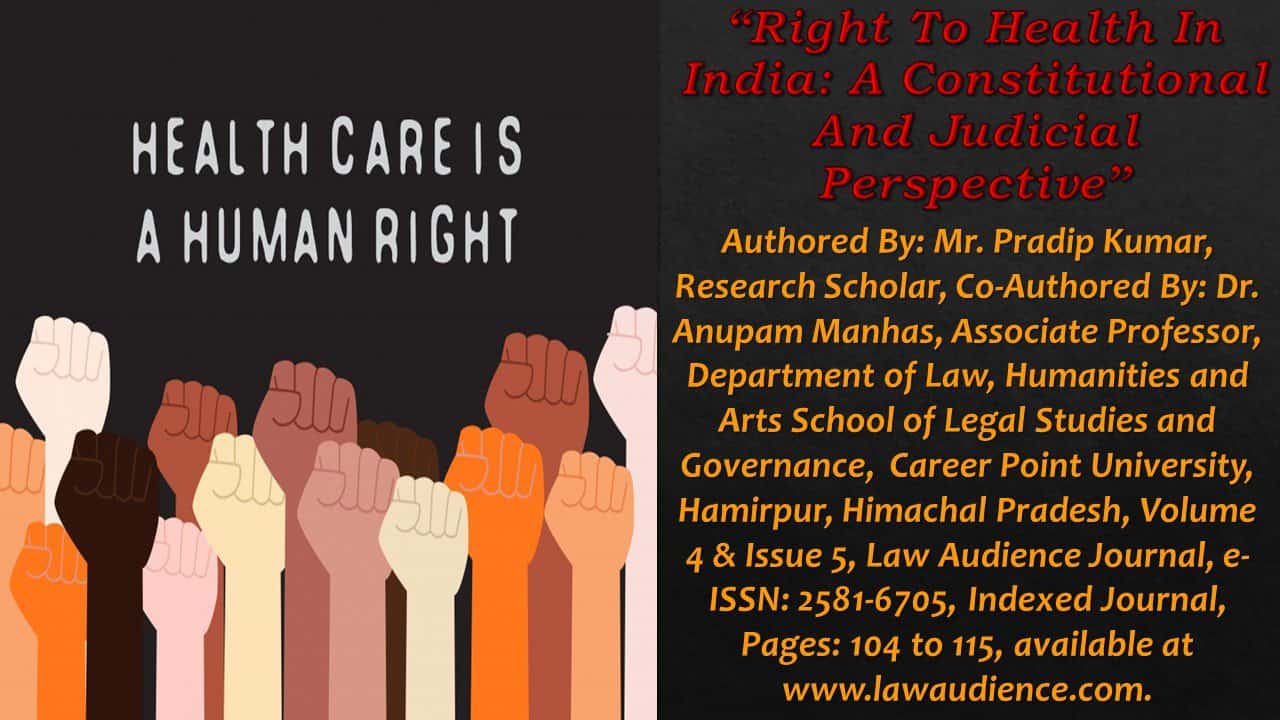Click here to download the full paper (PDF)
Authored By: Mr. Pradip Kumar, Research Scholar,
Co-Authored By: Dr. Anupam Manhas, Associate Professor, Department of Law, Humanities and Arts School of Legal Studies and Governance, Career Point University, Hamirpur, Himachal Pradesh,
Click here for Copyright Policy.
ABSTRACT:
“Health is the most important factor in national development. It is a condition of a person’s physical and mental state and signifies freedom from any disease or pain. Right to health is a vital right without which none can exercise one’s basic human rights. The Government is under obligation to protect the health of the people because there is close nexus between Health and the quality of life of a person. There are various provisions under the Constitution of India which deal with the Health of the Public at large. The founding fathers of the Indian Constitution rightly inserted Directive Principles of State Policy (DPSP) with a view to protect the health of the public at large. Health is the most precious prerequisite for happiness. The Supreme Court is performing Nobel function of interpretation of provisions of Constitution. the framers of Indian Constitution have rightly inserted various provisions regarding health of public”.
Keywords: Right to health, Fundamental right, Constitution, Health Care. Judicial.
“Health care is not a privilege. It’s a right. It’s a right as fundamental as civil rights. It’s a right as fundamental as giving every child a chance to get a public education.” …Rod Blagojevich
I. INTRODUCTION:
Health is wealth. “Everyone has the right to a standard of living adequate for the health and wellbeing of himself and of his family, including food, clothing, housing and medical care and necessary social services, and the right to security in the event of unemployment, sickness, disability, widowhood, old age or other lack of livelihood in circumstances beyond his control and motherhood and childhood are entitled to special care and assistance.”[1] The World Health Organization has also played a pivotal role in guiding health policy development and ensuring and attaining the highest standards of health care to all the people around the globe. Health is one of the basic requirements of human being. Nowadays India is facing problem of degradation of health. The Constitution of India is supreme law to govern the whole Nation. The condition of health is worsening day by day in spite of various health schemes and policies. The framers of Indian Constitution have rightly inserted various provisions regarding health of public. Further the role of Indian Supreme Court is significant in protecting health of people at large with the help of various decisions. The effective implementation of Laws enacted based on Constitutional provisions will control the Health problem. In Indian Constitution does not expressly recognize the fundamental right to health.
However, Article 21 of the Constitution of India guarantees a fundamental right to life & personal liberty. The expression ‘life’ in this article means a life with human dignity & not mere survival or animal existence. It has a much wider meaning which includes right to livelihood, better standard of life, hygienic condition in workplace & leisure. The right to health is inherent to a life with dignity, and Article 21 should be read with Articles 38, 42, 43, & 47 to understand the nature of the obligation of the state in order to ensure the effective realization of this right.
II. MEANING OF HEALTH AND HEALTH CARE:
The widely acceptable definition of health is that given by the WHO in the preamble of its constitution, according to World Health Organization, “Health is a state of complete physical, mental and social wellbeing and not merely the absence of disease”[2]. Through this definition, WHO has helped to move health thinking beyond a limited, biomedical and pathology-based perspective to the more positive domain of “well-being”. Also, by explicitly including the mental and social dimensions of well-being, WHO has radically expanded the scope of health and by extension, the role and responsibility of health professionals and their relationship to the larger society[3]. According to World Health Organization, health is a state of complete physical, mental and social wellbeing and not merely the absence of disease[4]. From the definition itself, it is clearly indicated that condition of life of the individual should incorporate physical, mental & social well-being & must be devoid of disease & infirmity. Thus, this pioneering institution (WTO) has played the best supportive role in guiding health policy development and action at the global and national levels, with an overall objective of ensuring & attaining the highest standards of health care to all the people around the world. WHO has not only given a wider definition to HEALTH but also brought the vision of HEALTH CARE.
The human right to health means that everyone has the right to the highest attainable standard of physical and mental health, which includes access to all medical services, sanitation, adequate food, decent housing, healthy working conditions, and a clean environment. The human right to health care means that hospitals, clinics, medicines, and doctors‟ services must be accessible, available, acceptable, and of good quality for everyone, on an equitable basis, where and when needed.
III. WHY THE RIGHT TO HEALTH?
Health and well-being are deeply personal matters. Nothing is more intimate than the experience of conceiving and bearing a child, and giving birth to a unique human being; none of us can live another’s fear or pain; and death itself is something we cannot share, however real the grief we suffer. And yet, it is precisely when we or those close to us face illness or chronic suffering that we perceive that health is in reality a very public issue. Policies which dictate what level of health care provision is guaranteed, what kinds of service will be offered, how priorities are established between competing claims, where resources are concentrated, and what alternatives are available all become far more immediate when they affect us or our loved ones. Economic policies that result in the underfunding of public services and the fragmentation of the regulatory role of government tend to reduce the threshold of what is considered an acceptable minimum standard of health-care provision for the population at large. Access to health care becomes dependent on the individual’s capacity to pay; patients are turned from citizens who have rights and responsibilities into clients or consumers.
Current trends suggest that “the enjoyment of the highest attainable standard of health” which WHO describes as “one of the fundamental rights of every human being” is seen almost as a by-product, something that will trickle down to the bottom sometime in the future. There is a long way to trickle before this fundamental right reaches those who are destitute (currently one fifth of the human race), those who survive precariously in the informal sector, or those whose access to health care is limited by their age or their disabilities, or by armed conflict. And while seven out of ten of the world’s poorest people are female, women’s health needs are widely neglected, whatever their background. Yet, if development is not for health, what is it for-and who can expect to enjoy it?[5]
IV. COMPONENTS OF RIGHT TO HEALTH:
IV.I THE RIGHT TO APPROPRIATE HEALTH CARE:
The right to health care requires the establishment of the health facilities, goods and services, such as hospitals, doctors and drugs, that are of good quality and available to all, on an equal basis. They must be affordable to everyone, respect dignity and diverse needs and operate transparently. These facilities must provide preventive, creative, palliative and rehabilitative health services, including regular screening programs, appropriate treatment of prevalent diseases, illnesses, injuries and disabilities, both physical and mental, and all necessary medications.[6]
IV.II RIGHT TO AN ADEQUATE SUPPLY OF WATER, FOOD, NUTRITION AND HOUSING:
The right health requires equal access for all to the underlying determinants of health, such as an adequate supply of food and proper nutrition, safe and potable water, basic sanitation, and adequate housing and living condition.[7]
IV.III THE RIGHT TO A HEALTHY ENVIRONMENT AND HEALTHY WORKING CONDITIONS:
The right to a healthy environment requires “the prevention and reduction of the population’s exposure to harmful substances…or other detrimental environmental conditions that directly or indirectly impact upon human health.” including the pollution of air, water and soil. The right to safe and healthy working condition requires the establishment of “preventive measures in respect of occupational accidents and diseases,” as well as the minimization of the “causes of health hazards inherent in the working environment.[8]
IV.IV THE RIGHT TO MATERNAL, CHILD AND REPRODUCTIVE HEALTH:
The right to health requires special provisions for improving child and mental health, sexual and reproductive health services as well as the treatment of disease affecting women, reduction of women’s health risks, and protection of women from domestic violence.[9]
IV.V THE RIGHT TO PARTICIPATE IN HEALTH-RELATED DECISION-MAKING:
The right to health requires the promotion of effective community participation in “setting priorities, making decisions, planning, implementing and evaluating strategies to achieve better health.”[10] This includes participation in the “provision of preventive and curative health services, such as the organization of the health sector, the insurance system and, in particular, participation in political decisions relating to the right to health taken at both the community and national level.”
V. RIGHT TO HEALTH UNDER INTERNATIONAL LAW:
Under international law, there is a right not merely to health care but to the much broader concept of health. Because rights must be realized inherently within the social sphere, this formulation immediately suggests that determinants of health and ill health are not purely biological or “natural” but are also factors of societal relations.[11] The first notion of a right to health under international law is found in the 1948 Universal Declaration of Human Rights (hereafter called Declaration), which was unanimously proclaimed by the UN General Assembly as a common standard for all humanity.[12]
The Declaration sets forth the right to a “standard of living adequate for the health and well-being of himself and his family, including . . . medical care and . . . the right to security in the event of . . . sickness, disability . . . or other lack of livelihood in circumstances beyond his control.” The Declaration does not define the components of a right to health; however, they both include and transcend medical care. The Cold War polarized countries ‟positions on human rights. In 1966, instead of the indissoluble whole reflected in the Declaration, twin covenants on civil and political rights and economic, social, and cultural rights were promulgated.[13] The right to health was included in the International Covenant on Economic, Social and Cultural Rights (ICESCR). Article 12 of the ICESCR explicitly sets out a right to health and defines steps that states should take to “realize progressively” “to the maximum available resources” the “highest attainable standard of health,” including “the reduction of the stillbirth-rate and of infant mortality and for the healthy development of the child”; “the improvement of all aspects of environmental and industrial hygiene”; “the prevention, treatment and control of epidemic, endemic, occupational and other diseases”; and “the creation of conditions which would assure to all medical service and medical attention in the event of sickness.[14] In addition to the ICESCR, a wide array of international and regional treaties recognizes health as a rights issue, and these reflect a broad consensus on the content of the norms. A review of the international instruments and interpretive documents makes it clear that the right to health as it is enshrined in international law extends well beyond health care to include basic preconditions for health, such as potable water and adequate sanitation and nutrition.
VI. PROVISIONS UNDER PART-III OF THE CONSTITUTION OF INDIA:
The Constitution of India not only provides for the health care of the people but also directs the state to take necessary measures to improve the condition of health of the people. Though the provisions enshrined under this part have no direct link with the healthcare, however from various judicial interpretations it has been established that the intention of the legislature were there to cover the health as a right of the citizens. Article 14 speaks about equality before law where the State shall not deny to any person equality before the law or the equal protection of the laws within the territory of India. Article 15 contains provisions for a particular application of the general principle of ‘equality of treatment’ embodied in Article 14. It prohibits discrimination against citizens on the grounds only of religion, race, caste, sex, place of birth or any of them. Further no citizen shall also be subjected to any disability, liability, restriction or condition with regard to access to shops, public restaurants, hotels and places of public entertainments; or the use of wells, tanks, bathing ghats, roads and places of public resort maintained wholly or partly out of State funds or dedicated to the use of the general public. Even nothing in this Article shall prevent the State from making any special provision for women and children for their betterment of life. Article 21 of the Indian Constitution ensures protection of life and personal liberty of the individual, where no person shall be deprived of his life or personal liberty except according to procedure established by law. Article 23 prohibits traffic in human beings and beggar and other similar forms of forced labour and any contravention of this provision shall be an offence punishable in accordance with law. Article 24 also prohibits the employment of children below the age of fourteen years in any factory or mine or in any other hazardous employment.
VII. PROVISIONS UNDER PART-IV OF THE CONSTITUTION:
Apart from the above fundamental rights, the Constitution of India provides for the following directive principles to be followed by the state regarding health care of the citizens. Article 38 in this regard provides that, “the State shall strive to promote the welfare of the people by securing and protecting, as effectively as it may, a social order in which justice– — social, economic and political, shall inform all the institution of the national life”. Thus, this is an imposition of liability on state that the State will secure a social order for the promotion of welfare of the people including public health because without public health welfare of people is practically meaningless. Article 39 further speaks that “the State shall, in particular, directs its policy towards securing;
(e) that the health and strength of workers, men and women, and the tender age of children are not abused and that citizens are not forced by economic necessity to enter avocations unsuited to their age or strength;
(f) that children are given opportunities and facilities to develop in a healthy manner and in conditions of freedom and dignity and that childhood and youth are protected against exploitation and against moral and material abandonment.”
Article 41 deals with right to work, education and public assistance in certain cases and thus imposed duty on the State to public assistance basically for those who are old, sick and disable. This Article specifically says that “the state shall within the limits of its economic capacity and development, make effective provisions for securing the right to work, to education and to public assistance in case of unemployment, old age, sickness and disablement, and in other cases of undeserved want”. Their implications in relation to health are obvious. Article 42 provides for just and humane conditions of work and maternity relief and gives the power to the State for making provisions in this regard, which implies that this Article is intended to protect the health of infants and mothers by providing maternity benefit.
Article 47 imposes duty on the State to raise the level of nutrition and the standard of living and to improve public health. It categorically provides that “the State shall regard the raising of the level of nutrition and the standard of living of its people and the improvement of public health as among its primary duties and, in particular, the State shall endeavour to bring about prohibition of the consumption except for medicinal purposes of intoxicating drinks and of drugs which are injurious to health.” Further, Article 48A ensures that State shall endeavour to protect and impose the pollution free environment for good health. Article 51 A (g) under Part IV – A of the Constitution says that “it shall be the duties of every individual to protect and improve the natural environment including forests, lakes, rivers and wild life, and to have compassion for living creatures.”
VIII. JUDICIAL RESPONSE:
With the recognition that both the Indian Constitution and the fundamental right of life emphasize human dignity, began to address the importance of health to Indian citizen. In the DPSP, Art.47 declares that the State shall regard the level of nutrition and the standard of living of its people and the improvement of public health as among its primary duties. Since DPSP are not enforceable by the court, implementation of the guarantee has remained illusory.[15] However, in a series of cases dealing with the substantive content of the right to life, the court has found that the right lives with human dignity including right to good health.[16] In Consumer Education and Research Center vs. UOI[17], the Court explicitly held that the right to health was an integral factor of a meaningful right to life. The court held that the right to health and medical care is a fundamental right under Article 21.
The Supreme Court, while examining the issue of the constitutional right to health care under arts 21, 41 and 47 of the Constitution of India in State of Punjab vs. Ram Lubhaya Bagga,[18] observed that the right of one person correlates to a duty upon another, individual, employer, government or authority. Hence, the right of a citizen to live under art 21 casts and obligation on the state. This obligation is further reinforced under Article 47; it is for the state to secure health to its citizens as its primary duty. No doubt the government is rendering this obligation by opening government hospitals and health centers, but to be meaningful, they must be within the reach of its people, and of sufficient liquid quality. Since it is one of the most sacrosanct and valuable rights of a citizen, and an equally sacrosanct and sacred obligation of the state, every citizen of this welfare state looks towards the state to perform this obligation with top priority, including by way of allocation of sufficient funds. This in turn will not only secure the rights of its citizens to their satisfaction, but will benefit the state in achieving its social, political and economic goals.
The Supreme Court, in Paschim Banga Khet mazdoor Samity & ors vs. State of West Bengal & ors,[19] while widening the scope of art 21 and the government’s responsibility to provide medical aid to every person in the country, held that in a welfare state, the primary duty of the government is to secure the welfare of the people. Providing adequate medical facilities for the people is an obligation undertaken by the government in a welfare state. Article 21 imposes an obligation on the state to safeguard the right to life of every person. Preservation of human life is thus of paramount importance. The government hospitals run by the state are duty bound to extend medical assistance for preserving human life. Failure on the part of a government hospital to provide timely medical treatment to a person in need of such treatment, results in violation of his right to life guaranteed under Article21.
The Court made certain additional direction in respect of serious medical cases:
- Adequate facilities be provided at the public health centers where the patient can be given basic treatment and his condition stabilized.
- Hospitals at the district and sub divisional level should be upgraded so that serious cases be treated there.
- Facilities for given specialist treatment should be increased and having regard to the growing needs, it must be made available at the district and sub divisional level hospitals.
- In order to ensure availability of bed in any emergency at State level hospitals, there should be a centralized communication system so that the patient can be sent immediately to the hospital where bed is available in respect of the treatment, which is required.
IX. CONCLUSION:
The term Right to health is nowhere mentioned in the constitution yet the Supreme Court has interpreted it as a fundamental right under Right to life enshrined in Article 21. It is a significant view of the Supreme Court that first it interpreted Right to Health under part IV. i.e., Directive Principles of State Policy. Till today no effective steps have been taken to implement the constitutional obligation upon the state to secure the health and strength of people. It has rightly been said that nutrition, health & education are the three inputs accepted as significant for the development of human resources. For achieving the Constitutional obligation and also objectives of Health care for all there is a need on the part of the government to mobilize nongovernmental organization and the general public towards their participation for monitoring and implementation of health care facilities.
Let’s learn together on Unacademy. Get 10% off on your subscription with my referral code PLUSUZ4R2.
Click on this link to subscribe https://unacademy.onelink.me/u7cm/xwdxv70r.
Cite this article as:
Mr. Pradip Kumar & Dr. Anupam Manhas, “Right To Health In India: A Constitutional And Judicial Perspective”, Vol.4 & Issue 5, Law Audience Journal (e-ISSN: 2581-6705), Pages 104 to 115 (18th February 2023), available at https://www.lawaudience.com/right-to-health-in-india-a-constitutional-and-judicial-perspective/.
Footnotes & References:
[1] Article 25 of the Universal Declaration of Human Rights, 1948.
[2] Preamble to the Constitution of the World Health Organization as adopted by the International Health Conference, New York, 19–22 June 1946; signed on 22 July 1947 by the representatives of 61 States (Official Records of the World Health Organization, no. 2, p. 100); and entered into force on 7 April 1948
[3] Kumar Avanish, “Human Right to Health”, Satyam Law International 2007 at 21
[4] Preamble to the Constitution of the WHO as adopted by the International Health Conference (Official records of the WHO, no 2, p. 100
[5] Deborah Eade, preface to Development for Health: Selected articles from Development in Practice, Oxford, UK: Oxfam (UK and Ireland, 1997), 4-5
[6] U.N. Committee on Economic, Social and Cultural Rights(CESCR), General Comment 14 (GC 14), Para 12
[7] General Comment 14 (GC 14), Para 12
[8] General Comment 14 (GC 14), Para 15
[9] General Comment 14 (GC 14), Para 21
[10] General Comment 14 (GC 14), Para 54
[11] UN Committee on Economic, Social and Cultural Rights. General Comment 14: The Right to the Highest Attainable Standard of Health. Geneva, Switzerland: United Nations: 2000. UN Document E/C.12/2000/4. available at: http://www.unhchr.ch/tbs/ doc.nsf/(symbol)/E.C.12.2000.4.En?OpenDocument. Accessed Dec.26, 2022.
[12] Universal Declaration of Human Rights. United Nations General Assembly Resolution 217 A (III). New York, NY: United Nations; 1948.
[13] Craven M. The International Covenant on Economic, Social and Cultural Rights: A Perspective on Its Development. Oxford, England: Clarendon Press; 1995.
[14] International Covenant on Economic, Social and Cultural Rights. New York, NY: United Nations; 1966. UN document A/6316. available at: http://www.unhchr.ch/ html/menu3/b/a_cescr.htm. Accessed Dec.26, 2022.
[15] Bandhua Mukti Morcha’case AIR 1984 SC 812
[16] Ibid, p. 811
[17] AIR 1995 SC 636
[18] (1998) 4 SCC 177: AIR 1998 SC 1703.
[19] (1996) 4 SCC 37



